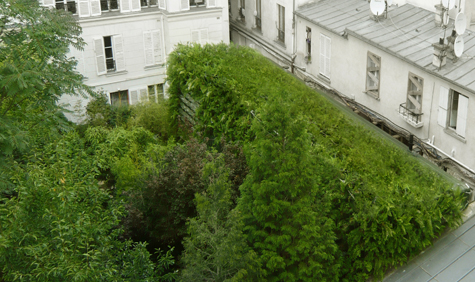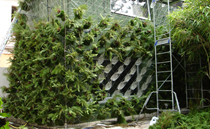’Lost in Paris’ house, by R&Sie architects

When Jean Nouvel’s Musée du Quai Branly opened in 2006, it certainly flagged up a trend, about living green façades in an urban context. Parisian architects R&Sie have been pioneers of the concept since the early 1990s, and with their latest house project, the idea was taken to new heights.
Appropriately named Lost in Paris, the 130 sq m building in South Paris, not only houses a family of four, but hosts a living laboratory of over 1,200 ferns or Dryopteris filix-mas.

See more plans, images during construction and the finished 'Lost in Paris' house
What makes the house's exterior green skin so unique is that it is a 'living' wall based on a hydroponics system. The ferns are wrapped around the structure and fed mechanically with a liquid mix of bacteria and need no soil base to grow. They get their nutrition drop by drop through 300 glass beakers full of especially prepared bacterial chemical culture mix while rainwater is collected to water the plants.
Under its green wrapping, the house itself is made of concrete. A polyurethane coat for insulation, sheltered in its turn by a thin plastic shell, covers the new-built structure. In order for the walls and the insulation layers to be protected from the plants’ roots, a distance was kept in-between the plastic layer and the hanging garden.
The beaker-feeders were created with traditional glass-blowing techniques, and the whole system works by itself, under of course the care and watchful eye of the owners, who received the system's 'instructions' from the design team, when they moved in.
The house remains green throughout the year, with small changes in the ferns' colourings and leaf thickness, according to the seasons, while the required type and amount of bacteria need to adjust in response to the light and weather conditions.
Wallpaper* Newsletter
Receive our daily digest of inspiration, escapism and design stories from around the world direct to your inbox.
Needless to say the experimental prototype house has caused some controversy around the neighbourhood; it took the architects five years to build it, as according to French planning permission the owners had to have 66% of the neighbours on their side, to go ahead with construction.
R&Sie’s Francois Roche explains: 'all our projects are based on a similar protocol; they touch the boundaries of architecture. It takes off from a typically ecological approach, but goes beyond that. People are always curious when they walk by but sometimes they find the system creepy, or even dangerous to some; it is a game of attraction and repulsion.'
Ellie Stathaki is the Architecture & Environment Director at Wallpaper*. She trained as an architect at the Aristotle University of Thessaloniki in Greece and studied architectural history at the Bartlett in London. Now an established journalist, she has been a member of the Wallpaper* team since 2006, visiting buildings across the globe and interviewing leading architects such as Tadao Ando and Rem Koolhaas. Ellie has also taken part in judging panels, moderated events, curated shows and contributed in books, such as The Contemporary House (Thames & Hudson, 2018), Glenn Sestig Architecture Diary (2020) and House London (2022).
-
 The Lighthouse draws on Bauhaus principles to create a new-era workspace campus
The Lighthouse draws on Bauhaus principles to create a new-era workspace campusThe Lighthouse, a Los Angeles office space by Warkentin Associates, brings together Bauhaus, brutalism and contemporary workspace design trends
By Ellie Stathaki
-
 Extreme Cashmere reimagines retail with its new Amsterdam store: ‘You want to take your shoes off and stay’
Extreme Cashmere reimagines retail with its new Amsterdam store: ‘You want to take your shoes off and stay’Wallpaper* takes a tour of Extreme Cashmere’s new Amsterdam store, a space which reflects the label’s famed hospitality and unconventional approach to knitwear
By Jack Moss
-
 Titanium watches are strong, light and enduring: here are some of the best
Titanium watches are strong, light and enduring: here are some of the bestBrands including Bremont, Christopher Ward and Grand Seiko are exploring the possibilities of titanium watches
By Chris Hall